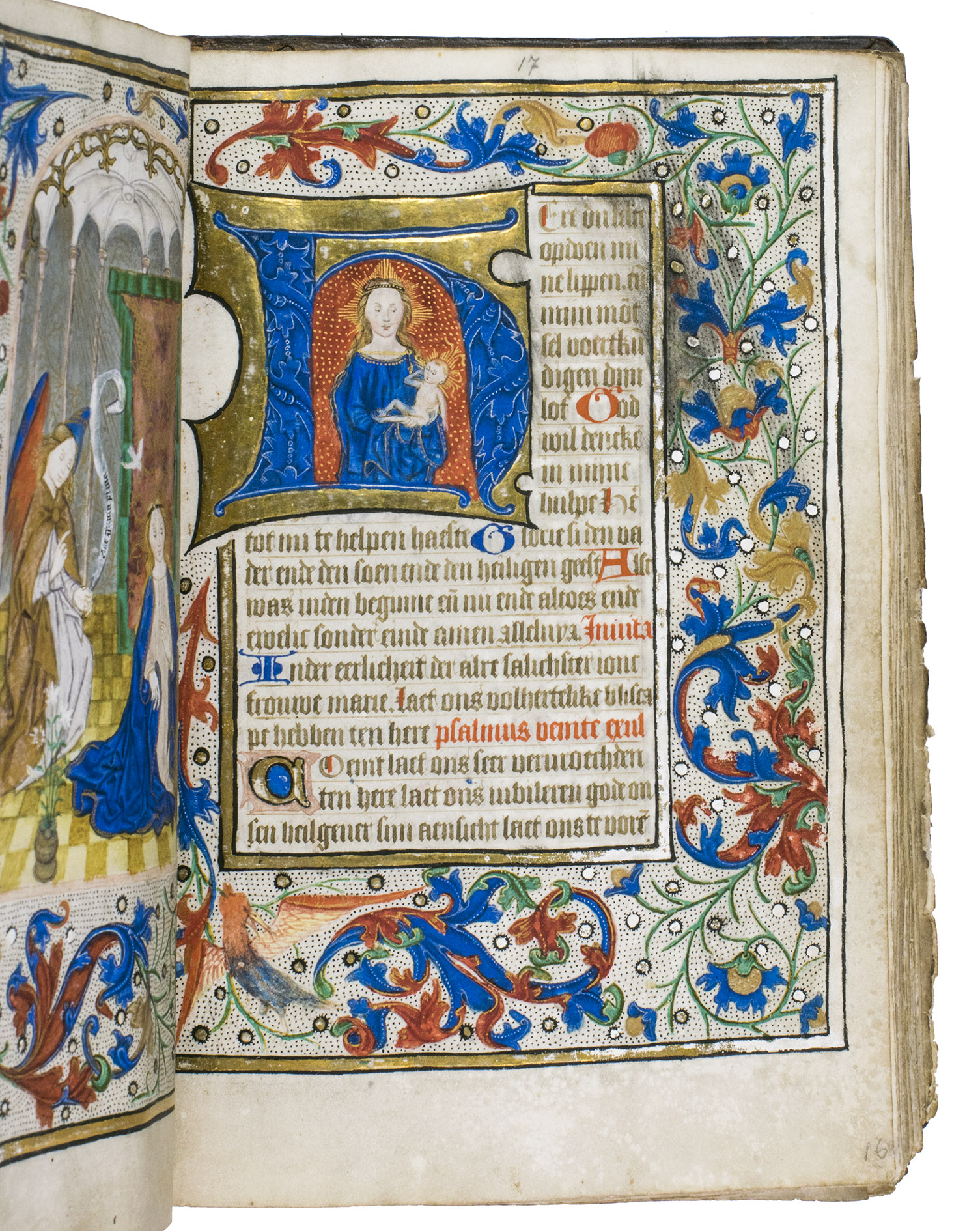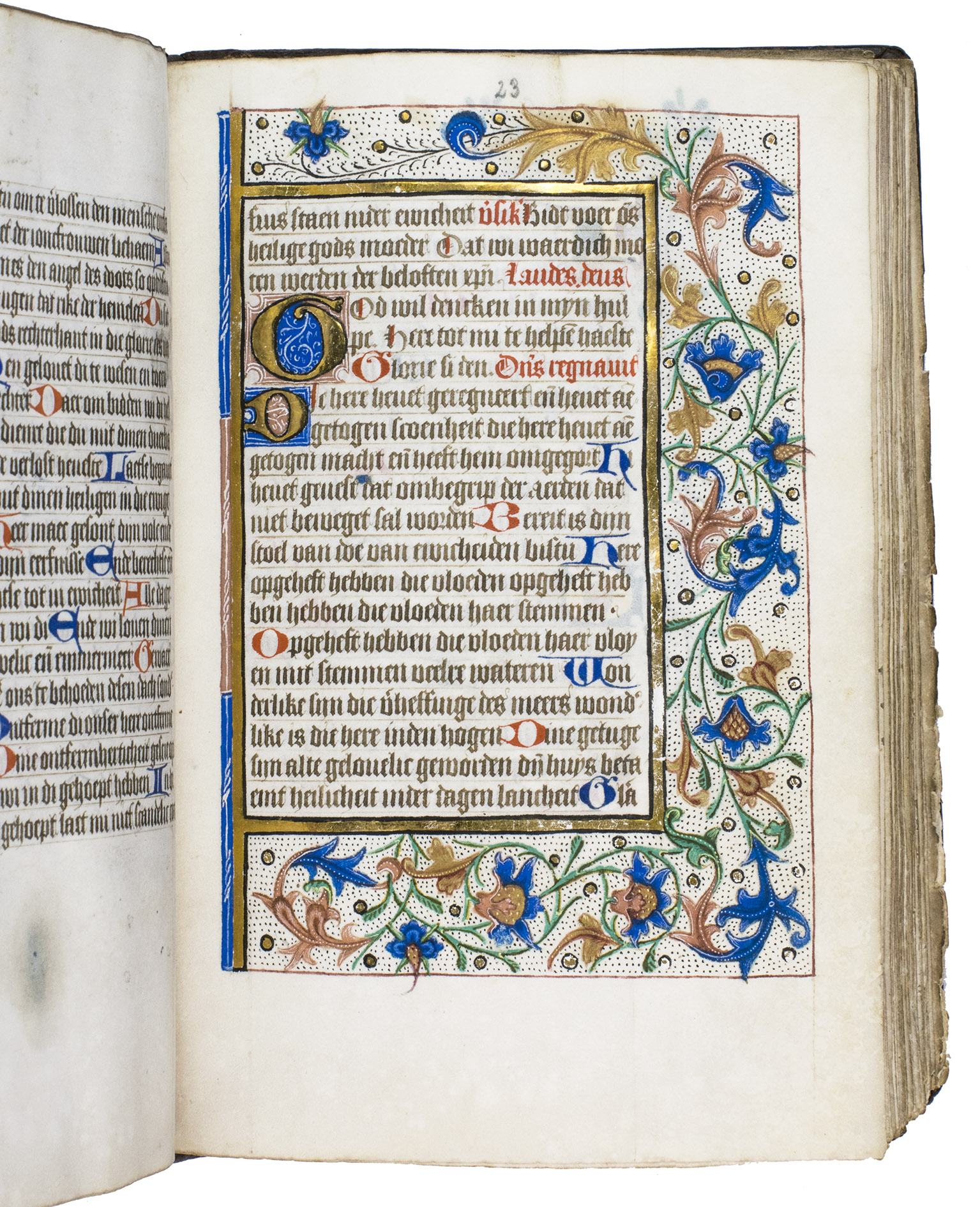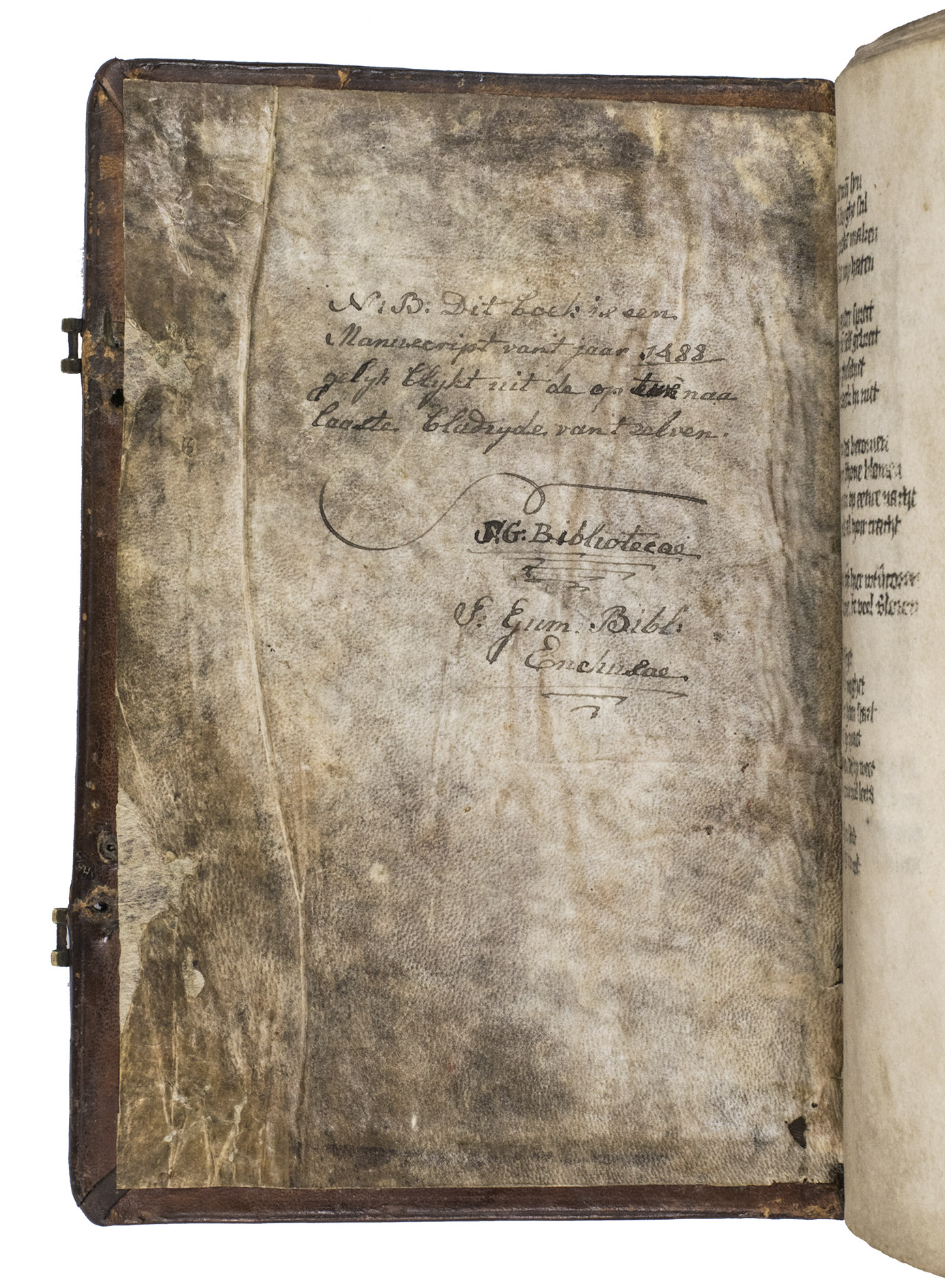[ILLUMINATED MANUSCRIPT - BOOK OF HOURS (DIOCESE OF UTRECHT)].
[Incipit, A2r:] Alst my gaet niet nae mij[n] syn / Soe wil ic my liden en[de] swyghe stil ...
[Diocese of Utrecht, the County of Holland], 1488. Large 8vo (19 x 13.5 x 4 cm). Written in Dutch on vellum by 2 gothic textura hands in 1 column (20 lines/page for the first hand for the main text and calendar; 22 lines/page for the additions written by the second hand). All leaves are numbered in pencil in the upper margin of the rectos by a 19th- or 20th-century hand. Richly iluminated by the Master of the Brussels Hours of the Bezborodko Group, being one of the stylistic groups of the Masters of the Dark Eyes, with 6 full-page miniatures, 2 historiated initials and 4 larger decorated initials, several smaller decorated initials, and many 1-line lombardic initials in blue and red. Also with a 6-line blue penwork initial on a red penwork ground, being a contemporary addition. Also with three- and four-marginal border decoration (an uncoloured background filled in with small dots or short tendrils in black, show acanthus leaves in different colours, various flowers and several brightly coloured birds and fabulous beings, with gold and black/white dots among them). Contemporary blind-tooled calf over rounded ("cushioned") wooden boards. With the original brass catch- and anchor-plates, the latter with remnants of the leather fastenings, and the later silk red ribbon markers loosely preserved. 144 ll. including 6 inserted leaves with miniatures and 2 blank endpapers used as paste-downs.
€ 140,000
An extensively and beautifully decorated Dutch-language book of hours, written on good quality vellum and dated 1488, and illuminated by the Master of the Brussels Hours of the Bezborodko Group, being one of the stylistic groups of the famous Masters of the Dark Eyes. The present book of hours was hitherto unrecorded as manuscript of these famous illuminators of medieval manuscripts and it appears to be the earliest example of a manuscript decorated by the Master of the Brussels Hours of the Bezborodko Group.
With regards to the text, the present manuscript can be considered as a quite common book of hours, as it contain texts often present in these books (the Hours of the Virgin, the Long Hours of the Cross, the Hours of the Holy Spirit, the Hours of Eternal Wisdom, the Office of the Dead and the Seven Penitential Psalms, including a litany) and some other suffrages and prayers. However, with regards to the decoration program, the present manuscript is notorious, as it was a yet unrecorded example of a manuscript illuminated by one of the Masters of the Dark Eyes, more specific the Master of the Brussels Hours of the Bezborodko Group. Many thanks to dr. Klara Broekhuijsen for conforming this and for providing us the material to study this manuscript in relation to other manuscripts of the Bezborodko Group.
The Masters of the Dark Eyes are considered to be the "most important and most prolific illuminators working in the County of Holland" (Broekhuijsen, Masters and miniatures) and were named after their most prominent feature: the heavy shadows around the eyes of their figures. They were responsible for the illumination of many works of which an unusually large number of over seventy manuscripts are left and they are known for the lavishness and extent of their decoration programmes. On stylistic grounds, the Masters of the Dark Eyes are divided into seven groups, all flourishing between ca. 1490-1510, of which one is called the Bezborodko Group, "the best among the Masters of the Dark Eyes in terms of quality" (Broekhuijsen, Masters and miniatures). Features of the Bezborodko Group are a refined use of colour, their specific border decoration (acanthus leaves in various colours, flowers and fabulous beasts with gold or black dots among them, leaving the bare vellum visible) and moreover their use of engravings and woodcuts as models for the compositions of their miniatures.
In the Bezborodko Group we distinguish two painters: the Master of the Bezborodko Hours and the Master of the Brussels Hours. The decoration program of this book of hours is an outstanding example of the work of the Master of the Brussels Hours. Differences between both Bezborodko Masters come out in the first place in their use of colour. The Master of the Brussels Hours has a preference for more dark reds and blues in the draperies of figures and in the border decoration instead of the softer colours (pink, yellow, pale blue) of the Master of the Bezborodko Hours. The border decoration in this manuscript show especially many vivid red and blue and especially the draperies of the figures in the miniatures are almost all painted in a dark deep blue. Another feature of the way they shape their figures in the miniatures. The figures as painted by the Master of the Brussels Hours are somewhat taller, slender and more elegant with finer faces, more pointed chins (especially for women) and sharper contours in contrast to the figures of the Master of the Bezborodko Hours, which have more thickset, compact forms with rounder faces. In the present manuscript the figures all have pointed chins. When we compare the compositions in the present book of hours with those in other manuscripts illuminated by the Master of the Brussels Hours, we find almost one-to-one matches in the decoration program.
The present manuscript is the earliest dated example of a book of hours illuminated by the Master of the Brussels Hours, being signed 1488. Five other manuscripts of the Bezborodko Group are dated (two date from 1489, one from 1490, two from 1491). It is quite hard to say precisely where the manuscript must have been made, as it is for almost every manuscript illuminated by the Masters of the Dark Eyes, but we can assume that the present book of hours is illuminated in the former County of Holland.
The present manuscript was long time unrecorded as a manuscript illuminated by one of the Masters of the Dark Eyes because it circulated for years in private collections. We know that the manuscript was formerly part of the library of the Old Catholic Clergy of Sts. Gummarus and Pancratius in Enkhuizen (based upon the 19th-century inscription on the verso of the front endpaper). In May 1909 the manuscript was at auction (Frederik Muller, nr. 814) and again a year later, on 16-17 June 1910 (nr. 1736), where it was bought by the jurist W.H. Köhler, living in Maarssen. The manuscript was sold again on auction at Van Huffelen on 7 February 1946, where it was bought by W.A. Hofman. From then on, the present manuscript remained family property, obtained by the current owner by inheritance.
Binding slightly worn and professionally restored around the spine. Fastenings (2) and 1 anchor plate lost. Some marginal dust-soiling of the leaves, some marginal spots and stains, a few very minor marginal tears (never affecting the miniatures or text), two small wormholes in the last quire (not affecting the text) and some more worming on the last endpaper, endpapers browned and chipped, a few marginal creases, some miniatures, initials and border decoration show signs of wear, but overall the book of hours, being a beautiful and curious example of book illumination by one of the Masters of the Dark Eyes, is still in good condition. The description made by Willem de Vreese of the present manuscript can be found in the Bibliotheca Neerlandica Manuscripta, 856. For the Masters of the Dark Eyes and the Brezborodko group: Klara H. Broekhuijsen, The Masters of the Dark Eyes. Late medieval manuscript painting in Holland (2009); Klara H. Broekhuijsen, Masters and miniatures. Proceedings of the congress on medieval manuscript illumination in the Northern Netherlands (Utrecht, 10-13 December 1989), pp. 403-412.
Related Subjects:

























